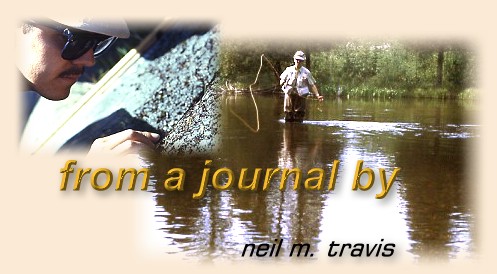Defining the Sport
By Neil M. Travis, Montana
The Nineteenth-Century was a pivotal point in the history
of fly-fishing, and many of the practices that we employ
today were first codified during this period by the English
anglers whose names have become synonymous with the sport.
In 1836 Alfred Ronalds published his classic book
Fly-Fisher's Entomology, ushering in the
scientific age of insect identification. So popular was
this book that it was reprinted twelve times with the last
edition being published in 1920, nearly a century after the
first edition. Ronalds did not merely write about entomology,
but his work included numerous observations about trout
behavior, and his diagrams on the refraction of light
entering the water were revolutionary for their time. His
watercolor plates set the standard for later writers to
follow, and his work is one of the milestones in the history
of fly-fishing.
During this period the dry fly method of angling began to
appear in print and practice on the English chalkstreams.
It is important to understand that fishing with a dry fly
was not a 'eureka' moment when someone suddenly discovered
that they could make an artificial fly float on the surface
like a natural. There has been much debate among angling
historians concerning when and where the first dry flies
were used, but it was George Pulman who first described
the dry fly method in his book Vade Mecum of Fly-Fishing
for Trout first published in 1841. Pulman does not
merely mention dry fly fishing in his book, but he describes
it in detail mentioning the need to imitate a specific insect
as to size and color. He understood the need to have the
artificial float naturally on the surface of the water without
unnatural drag and that it must come to the trout from upstream.
While it is possible that some of these observations were original
to Pulman, most angling historians do not believe that he was the
first to observe or practice them. Pulman never claimed to have
invented dry fly fishing, and it seems best to understand that
he was merely reporting a practice that was already well
advanced by his time.
Whatever Pulmans' role was in the evolution of the dry fly
fishing method, it is clear that his writings about this
method were foundational in the later development our sport.
With the scientific approach to insect identification set
forth by Ronalds' and the dry fly method codified by Pulman,
all of the foundational groundwork had now been laid for the
anglers that would follow.
The fact that the technique of fishing with a dry fly developed
in a variety of separate places is illustrated by several facts.
Pulman lived in a small Devonshire town of Axminister, and he
fished on rivers in that area, principally the Barle, Exe, and
Axe. Halford wrote that he first observed the dry fly method at
Charhalton on the Wandle, and Francis Francis published an article
in The Field in 1857 recommending the dry fly method for
fishing when the surface was flat and smooth. He further commented
that both matching the hatch and dry fly fishing had been in practice
on the Hampshire chalkstreams for many years. However, William
Stewart in his classic book Practical Angler
published in 1857 makes no mention of the dry fly method on his
home rivers around the Tweed.
Stewart was a skilled wet fly angler, his book is an angling
classic and remained in print for nearly a century. He was an
attorney and could afford to spend considerable time angling
and thinking about angling. He established the philosophy of
the upstream school of presentation of wet flies and was a
champion of the soft hackled wet flies that are still copied
today. While Stewart did not invent the upstream method of
presenting the wet fly, he was the first to set forth in print
a well reasoned case for the practice.
In 1867 Francis Francis published A Book on Practical Angling
and attempted to establish a balanced approach between the two
developing philosophies of angling; the wet fly and the dry. He
argued that a skillful angler needed to master all the methods,
but his arguments did little to dampen the battles between to
two positions that were soon to erupt onto the peaceful stage
of the gentle and contemplative sport perceived by Izaak Walton
over 200 years earlier. ~ Neil M. Travis, Montana/Arizona
From A Journal Archives
|

